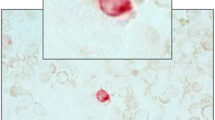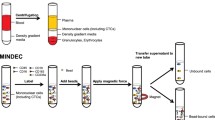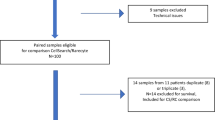Abstract
Purpose: A negative selection method for the enumeration and characterization of circulating epithelial/cancer cells (CCC) in Breast Cancer (BC) patients is described. This manual procedure yields reproducible results of high sensitivity and selectivity suitable for research laboratories. Patients and methods: We conducted a prospective blood sampling study in 105 women with stage 1–4 BC attending clinics at the University of Maryland Greenebaum Cancer Center to define the prevalence of CCC utilizing our sensitive double gradient centrifugation and magnetic cell sorting CCC detection and enumeration method. CCC were isolated and enumerated from 15 to 20 ml of venous blood drawn before the start of systemic therapy and periodically thereafter for up to 24 months. One or more CCC/sample was considered a positive result. Results: We analyzed 487samples for the presence of CCC; the median number of samples/patient was 4 (range 1–8). CCC were detected in 56% of patients, 19%—stage 1; 43%—stage 2; 46%—stage 3; 83%—stage 4. The probability of being positive for the presence of CCC is significantly associated with the stage of cancer (P < 0.0001). The frequency of CCC positive patients and samples increased with the advancing stage of disease. Presence of more than 10 CCC/sample was associated with the decreased survival and increased probability of having metastatic disease P = 0.001. Conclusions: Increasing number of CCC/sample correlates with the adverse outcome and poorer survival (P < 0.0001). Our CCC test based on the negative selection procedure may provide valuable prognostic information.



Similar content being viewed by others
References
Cristofanilli M et al (2004) Circulating tumor cells, disease progression, and survival in metastatic breast cancer. N Engl J Med 351(8):781–791
Cristofanilli M et al (2005) Circulating tumor cells: a novel prognostic factor for newly diagnosed metastatic breast cancer. J Clin Oncol 23(7):1420–1430
Cristofanilli M (2006) Circulating tumor cells, disease progression, and survival in metastatic breast cancer. Semin Oncol 33(3 Suppl 9):S9–S14
Alvero AB et al (2004) Improved method for the detection of cytokeratin 19-positive cells in the peripheral blood of breast cancer patients. Lab Invest. 84(5):658–661
Allard WJ et al (2004) Tumor cells circulate in the peripheral blood of all major carcinomas but not in healthy subjects or patients with nonmalignant diseases. Clin Cancer Res 10(20):6897–6904
Braun S, Marth C (2004) Circulating tumor cells in metastatic breast cancer—toward individualized treatment? N Engl J Med 351(8):824–826
Braun S, Naume B (2005) Circulating and disseminated tumor cells. J Clin Oncol 23(8):1623–1626
Budd GT et al (2006) Circulating tumor cells versus imaging—predicting overall survival in metastatic breast cancer. Clin Cancer Res 12(21):6403–6409
Hayes DF et al (2006) Circulating tumor cells at each follow-up time point during therapy of metastatic breast cancer patients predict progression-free and overall survival. Clin Cancer Res 12(14 Pt 1):4218–4224
Witzig TE et al (2002) Detection of circulating cytokeratin-positive cells in the blood of breast cancer patients using immunomagnetic enrichment and digital microscopy. Clin Cancer Res 8(5):1085–1091
Webster DR, Sabbadini E (1967) The prognostic significance of circulating tumor cells: a five-year follow-up study of patients with cancer of the breast. Can Med Assoc J 96(3):129–131
Sabbatini R et al (2000) Detection of circulating tumor cells by reverse transcriptase polymerase chain reaction of maspin in patients with breast cancer undergoing conventional-dose chemotherapy. J Clin Oncol 18(9):1914–1920
Ring AE et al (2005) Detection of circulating epithelial cells in the blood of patients with breast cancer: comparison of three techniques. Br J Cancer 92(5):906–912
Ts’o PO et al (1997) Detection of intact prostate cancer cells in the blood of men with prostate cancer. Urology 49(6):881–885
Wang ZP et al (2000) Identification and characterization of circulating prostate carcinoma cells. Cancer 88(12):2787–2795
Muller V et al (2005) Circulating tumor cells in breast cancer: correlation to bone marrow micrometastases, heterogeneous response to systemic therapy and low proliferative activity. Clin Cancer Res 11(10):3678–3685
Muller V, Pantel K (2004) Bone marrow micrometastases and circulating tumor cells: current aspects and future perspectives. Breast Cancer Res 6(6):258–261
Muller V, Pantel K (2005) BM micrometastases and circulating tumor cells in breast cancer patients: where have we been, where are we now and where does the future lie? Cytotherapy 7(6):478–482
Tang C, Lin AY (2004) Circulating epithelial cells in breast cancer. N Engl J Med 351(23):2452–2454; author reply 2452–2454
Taback B et al (2001) Detection of occult metastatic breast cancer cells in blood by a multimolecular marker assay: correlation with clinical stage of disease. Cancer Res 61(24):8845–8850
Gaforio JJ et al (2003) Detection of breast cancer cells in the peripheral blood is positively correlated with estrogen-receptor status and predicts for poor prognosis. Int J Cancer 107(6):984–990
Fehm T et al (2002) Cytogenetic evidence that circulating epithelial cells in patients with carcinoma are malignant. Clin Cancer Res 8(7):2073–2084
Fehm T et al (2005) Methods for isolating circulating epithelial cells and criteria for their classification as carcinoma cells. Cytotherapy 7(2):171–185
Acknowledgement
The work done at CCC Diagnostics LLC is supported by NCI Grant #CA081903.
Author information
Authors and Affiliations
Corresponding author
Additional information
Partly presented at the 41st and 42nd Annual Meeting of the American Society of Clinical Oncology, May 2005, Orlando, FL, USA and June, 2006, Atlanta, GA, USA.
Rights and permissions
About this article
Cite this article
Tkaczuk, K.H.R., Goloubeva, O., Tait, N.S. et al. The significance of circulating epithelial cells in Breast Cancer patients by a novel negative selection method. Breast Cancer Res Treat 111, 355–364 (2008). https://doi.org/10.1007/s10549-007-9771-9
Received:
Accepted:
Published:
Issue Date:
DOI: https://doi.org/10.1007/s10549-007-9771-9




